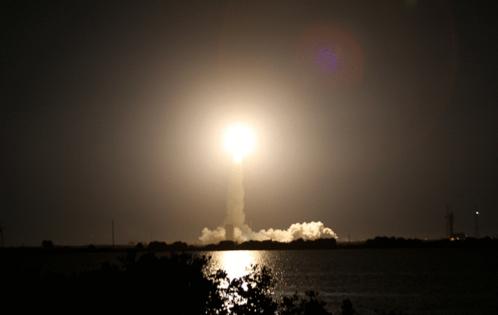ULA Vulcan cuts through night skies on landmark national security mission
Published in News & Features
CAPE CANAVERAL, Fla. — United Launch Alliance knocked out its first Vulcan Centaur launch of the year Tuesday night, and its first ever for the Space Force.
The company’s new workhorse rocket lifted off on the USSF-106 mission from Cape Canaveral Space Force Station’s Space Launch Complex 41 at 8:56 p.m. under clear skies except for a passing meteor that lit up the Space Coast about 10 minutes before launch.
The rumble of the engines set off car alarms in the distance as ULA opened up its national security account for Vulcan, making only its third ever launch after flying two certification flights in 2024.
Its payload is two satellites, including the Navigation Technology Satellite-3 headed to geostationary orbit. Built by L3Harris, it’s funded by the Air Force Research Laboratory and could be a potential replacement technology for GPS. The other satellite is classified.
The mission was awarded to ULA back in 2020 and was originally targeting launch by 2022, but delays in Vulcan development pushed its first two launches to 2024, both of which were needed before the Space Force would certify it to fly.
Vulcan has 26 more national security task orders to fly already under contract, with more expected to awarded in the next few years. Several of those are behind schedule, though, because of the rocket’s development delays.
But even though it’s coming three years later, its debut signifies a significant milestone for national security launches.
“Pretty historic point in our program history. We officially end our reliance on Russian-made main engines with this launch,” said Col. Jim Horne III, the mission director and senior materiel leader for the Space Force’s Space Systems Command.
ULA’s Vulcan, which features two BE-4 engines built by U.S.-based Blue Origin, is a replacement for its Atlas V and recently retired Delta IV rockets. Those rockets had engines supplied by Russia. A congressional requirement passed earlier this decade directed the Department of Defense to stop using any Russian-made rocket engines on their missions.
The DOD’s other primary launch provider, SpaceX, always made their engines in the U.S., as does Blue Origin, which has secured future launch contracts.
“We continue to maintain our assured access to space with at least two independent rocket service companies that we can leverage to get our capabilities in orbit,” Horne said.
ULA and SpaceX split the last round of national security missions awarded between 2020-2024 to be flown between 2022-2028 that were worth about $8.5 billion.
The two companies have the largest pieces of the pie for the new five-year phase of task orders, which will be worth at least $13.7 billion covering 84 expected missions as they are doled out from 2025-2029 for launches through 2032. Blue Origin will also be among the mix when its New Glenn rocket gets certified.
For the Space Force, Horne said it’s good to get back to the business of launching missions.
“Obviously have a backlog of missions that we’re working through,” he said. “We really just want to focus on this one, but you know I will say that we’re ready and postured to launch as quickly as we can as we work through that backlog.”
ULA has its next mission for the Space Force, USSF-87, which was awarded in 2021 and planned for a 2023 launch, as its next national security mission, which could be among the six rocket launches ULA plans to fly before the end of the year.
But step one is getting USSF-106 off the ground.
“This will be the most powerful Vulcan yet,” said ULA’s Gary Wentz, vice president of its government and commercial programs.
The first two certification flights used two solid rocket boosters to augment the power of its two BE-4 engines. This launch will feature four, so combined its rocket power will have more than 2.9 million pounds of thrust on liftoff.
“Really looking forward to seeing it clear the pad,” he said. “This mission is headed directly to geosynchronous orbit and will be one of our longest missions to date. And if you’re tracking the history of Vulcan, this is the sole purpose of this vehicle. It was purposely designed to support these missions doing direct injection geo for the Space Force.”
A more powerful version of Vulcan has up to six solid rocket boosters that can give it more than 3.8 million pounds of thrust, and that will be the version used when Vulcan flies its first commercial flight for Amazon’s Project Kuiper.
The launch will be the 101st national security flight with the previous flown on ULA’s stable of Atlas and Delta rockets since the company was formed in 2006 as a partnership between Lockheed Martin and Boeing.
“We’re proud to have delivered the majority of our country’s critical satellites to orbit and look forward to continuing this capability,” Wentz said. “Vulcan incorporates the best of the legacy of Atlas and Delta, and it’s created a single launch vehicle for ULA to support the full spectrum of needs demanded by our national security space customer.”
_____
©2025 Orlando Sentinel. Visit at orlandosentinel.com. Distributed by Tribune Content Agency, LLC.







Comments